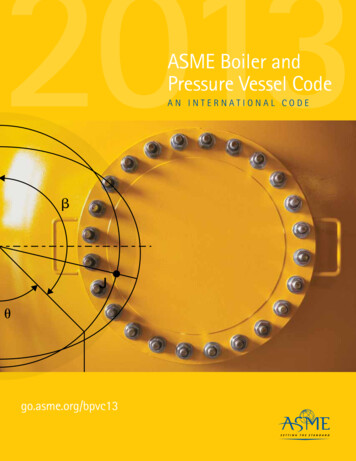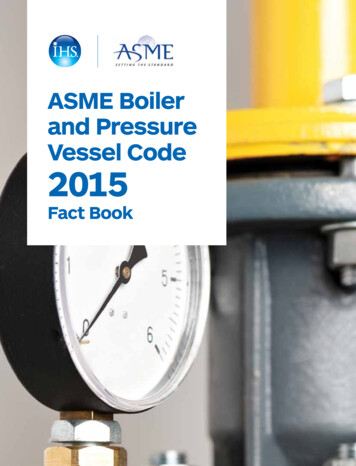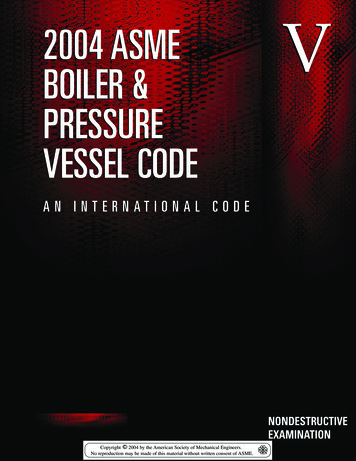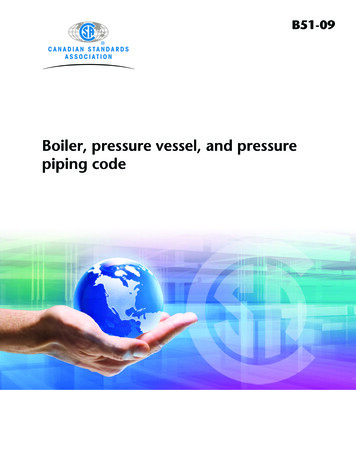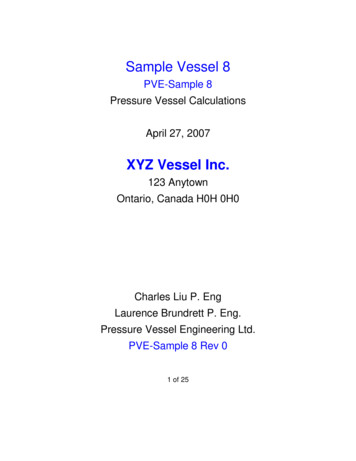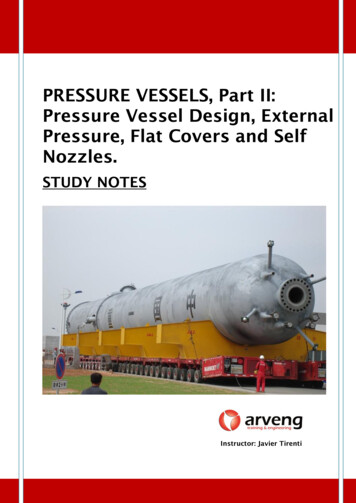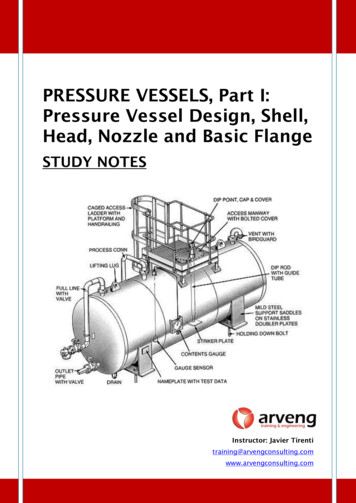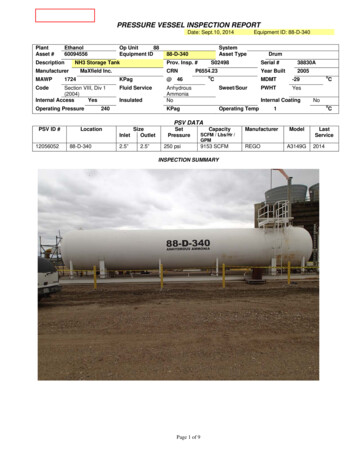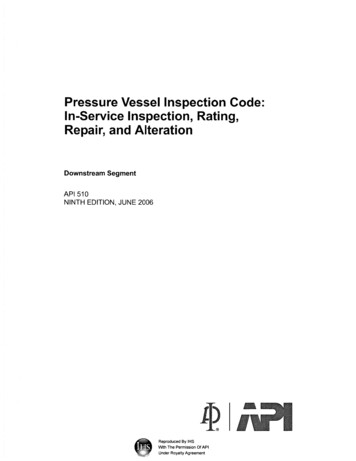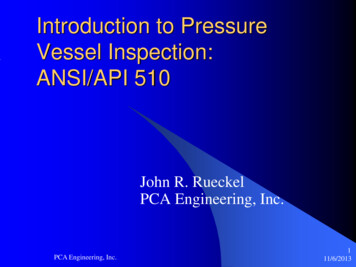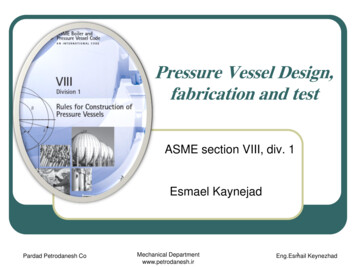
Transcription
ORNL/TM-2017/66ASME Boiler and Pressure Vessel CodeEvaluation and Equivalence Study forLiquefied Natural Gas FacilitiesBarry OlandMark LowerSimon RoseApril 2017
This report was prepared as an account of work sponsored by anagency of the United States Government. Neither the United StatesGovernment nor any agency thereof, nor any of their employees,makes any warranty, express or implied, or assumes any legal liabilityor responsibility for the accuracy, completeness, or usefulness of anyinformation, apparatus, product, or process disclosed, or representsthat its use would not infringe privately owned rights. Reference hereinto any specific commercial product, process, or service by trade name,trademark, manufacturer, or otherwise, does not necessarily constituteor imply its endorsement, recommendation, or favoring by the UnitedStates Government or any agency thereof. The views and opinions ofauthors expressed herein do not necessarily state or reflect those ofthe United States Government or any agency thereof.
ORNL/TM-2017/66Energy and Transportation Science DivisionASME Boiler and Pressure Vessel Code Evaluation and Equivalence Studyfor Liquefied Natural Gas FacilitiesBarry OlandMark LowerSimon RoseDate Published: April 2017US Department of TransportationPipeline and Hazardous Materials Safety AdministrationPipeline Safety ProgramEast Building Second Floor1200 New Jersey Avenue, S.E.Washington, DC 20590Pipeline and Hazardous Materials Safety AdministrationAgreement Number DTPH56-13-X-000022under DOE Proposal Number 2117-S865-A1Prepared byOak Ridge National LaboratoryOak Ridge, TN 37831-6283managed byUT-BATTELLE, LLCfor theUS DEPARTMENT OF ENERGYunder contract DE-AC05-00OR22725
CONTENTSCONTENTS .iiiLIST OF FIGURES . ixLIST OF TABLES . xiACRONYMS AND ABBREVIATIONS .xiiiACKNOWLEDGMENTS . xvABSTRACT . xviiEXECUTIVE SUMMARY . .52.6MATERIALS . xixDESIGN . xxE.2.1 Failure Modes. xxE.2.2 Strength Theories . xxivE.2.3 Principles of Limit Design Theory . xxivFABRICATION AND INSPECTION . xxvPRESSURE TESTING . xxviOVERPRESSURE PROTECTION . xxviiCONCLUSIONS AND OBSERVATIONS .xxviiiE.6.1 Conclusions .xxviiiE.6.2 Observations . xxixINTRODUCTION . 1RULEMAKING AND REGULATORY REVIEW PROCESS . 2FEDERAL SAFETY STANDARDS FOR LNG FACILITIES IN 49 CFR Part 193 . 51.2.1 Framework for Safety Equivalency . 51.2.2 NFPA and ASME Codes and Standards Incorporated by Reference in 49CFR Part 193. 61.2.3 Equivalency Provision in NFPA 59A . 6PURPOSE AND NEED FOR SAFETY EQUIVALENCY EVALUATION . 71.3.1 Safety Equivalency Evaluations using Quantitative Comparative Analysis. 71.3.2 Safety Equivalency Evaluations Using Qualitative Comparative Analysis . 8SAFETY EQUIVALENCY EVALUATION SCOPE AND OBJECTIVES . 8ASME BPVC SCOPE AND REVISION PROCESS . 9SECTION I – RULES FOR CONSTRUCTION OF POWER BOILERS . 11SECTION VIII, DIVISION 1 – RULES FOR CONSTRUCTION OF PRESSUREVESSELS . 12SECTION VIII, DIVISION 2 – ALTERNATIVE RULES FOR CONSTRUCTION OFPRESSURE VESSELS . 13SECTION II – MATERIALS . 142.4.1 Material Specifications – Parts A, B, and C. 142.4.2 Material Properties – Part D . 15SECTION V – NONDESTRUCTIVE EXAMINATION. 15SECTION IX – QUALIFICATION STANDARD FOR WELDING, BRAZING, ANDFUSING PROCEDURES; WELDERS; BRAZERS; AND WELDING, BRAZING,AND FUSING OPERATORS . 16iii
.102.6.1 Procedure Qualifications . 162.6.2 Performance Qualifications . 172.6.3 Welding, Brazing, and Fusing Data . 17SECTION XI – RULES FOR INSERVICE INSPECTION OF NUCLEAR POWERPLANT COMPONENTS . 17MATERIALS SPECIFICATIONS AND MATERIAL PROPERTIES . 19MATERIALS PERMITTED FOR DESIGN AND FABRICATION OF BOILERSAND PRESSURE VESSELS . 19TEMPERATURE-DEPENDENT AND TIME-DEPENDENT PROPERTIES . 24TOUGHNESS PROPERTIES . 24FATIGUE PROPERTIES . 24CORROSION PROPERTIES . 25DESIGN . 27POTENTIAL FAILURE MODES . 274.1.1 Excessive Elastic Deformation and Elastic Instability. 284.1.2 Excessive Plastic Deformation . 304.1.3 Brittle Fracture . 304.1.4 Stress Rupture and Creep Deformation. 514.1.5 Plastic Instability – Incremental Collapse . 524.1.6 Fatigue . 544.1.7 Stress Corrosion and Corrosion Fatigue . 57DESIGN BASIS . 594.2.1 Design Basis Requirements in Section I . 594.2.2 Design Basis Requirements in Section VIII, Division 1 . 604.2.3 Design Basis Requirements in Section VIII, Division 2 . 61STRESS CATEGORIES . 624.3.1 Primary Stresses . 634.3.2 Secondary Stresses . 634.3.3 Peak Stresses . 63MAXIMUM ALLOWABLE DESIGN STRESSES . 634.4.1 Basis for Establishing Allowable Stress Values for Section I and SectionVIII, Division 1 . 644.4.2 Basis for Establishing Allowable Stress Values for Section VIII, Division 2 . 664.4.3 Alternative Rules for Material Having a Higher Allowable Stress at LowTemperature . 69STRENGTH THEORIES. 704.5.1 Maximum Stress Theory . 704.5.2 Maximum Shear Stress Theory Using the Tresca Yield Criterion . 704.5.3 Distortion Energy Theory Using the von Mises Yield Criterion . 71PRINCIPLES OF LIMIT DESIGN THEORY . 71STRESS RANGE FOR REPETITIVELY APPLIED LOADS . 74PLASTIC COLLAPSE . 794.8.1 Plastic Collapse Requirements in Section I and Section VIII, Division 1 . 794.8.2 Plastic Collapse Requirements in Section VIII, Division 2 . 79DESIGN-BY-RULE . 804.9.1 Design-by-Rule Requirements in Section I. 804.9.2 Design-by-Rule Requirements in Section VIII, Division 1 . 814.9.3 Design-by-Rule Requirements in Section VIII, Division 2 . 83DESIGN-BY-ANALYSIS . 86iv
4.115.5.15.25.35.45.55.66.6.16.26.37.7.1COMPARISON OF KEY DIFFERENCES IN ASME BPVC DESIGN RULES. 89FABRICATION . 93FORMING . 935.1.1 Forming Requirements in Section I . 935.1.2 Forming Requirements in Section VIII, Division 1 . 945.1.3 Forming Requirements in Section VIII, Division 2 . 95TOLERANCES . 955.2.1 Formed Head Tolerances . 955.2.2 Alignment Tolerances . 96WELDING AND BRAZING PROCESSES . 975.3.1 Base Metal Groupings . 975.3.2 Welding and Brazing Methods. 985.3.3 Procedure Qualification Record . 995.3.4 Procedure Specification . 995.3.5 Procedure Specification Record . 1005.3.6 Performance Qualification . 1005.3.7 Performance Qualification Record . 1005.3.8 Welding, Brazing, and Fusing Data . 100HEAT TREATMENT OF WELDMENTS . 1015.4.1 Preheating Requirements . 1015.4.2 Postweld Heat Treatment Requirements . 101COLD STRETCHING . 1045.5.1 Summary of Cold Stretching Requirements in Section VIII, Division 1 . 1045.5.2 Cold Stretching Technology . 106QUALITY CONTROL . 1075.6.1 Quality Control System Requirements in Section I . 1085.6.2 Quality Control System Requirements in Section VIII, Division 1 . 1095.6.3 Quality Control System Requirements in Section VIII, Division 2 . 112INSPECTION AND EXAMINATION . 115GENERAL INSPECTION AND TEST REQUIREMENTS . 115NONDESTRUCTIVE EXAMINATION (NDE) requirements. 1166.2.1 General NDE Requirements in Section I . 1176.2.2 General NDE Requirements in Section VIII, Division 1 . 1196.2.3 General NDE Requirements in Section VIII, Division 2 . 1226.2.4 Acceptance Standards . 1246.2.5 Certification Requirements for NDE Personnel . 1346.2.6 Summary of Differences in NDE Requirements between the 1992 and 2015Editions . 137NDE TECHNOLOGY . 1416.3.1 General NDE Requirements in Section V . 1426.3.2 Radiographic Examination Requirements in Section V. 1426.3.3 Ultrasonic Examination Requirements in Section V . 1446.3.4 Liquid Penetrant Examination Requirements in Section V . 1456.3.5 Magnetic Particle Examination Requirements in Section V . 1456.3.6 Visual Examination Requirements in Section V . 146TESTING . 147PRESSURE TESTING . 1477.1.1 Basis for Pressure Testing Limits in Section I of the ASME BPVC . 147v
7.1.27.27.38.8.18.28.38.49.9.19.29.3Basis for Pressure Testing Limits in Section VIII, Division 1 of the ASMEBPVC . 1517.1.3 Basis for Pressure Testing Limits in Section VIII, Division 2 of the ASMEBPVC . 1597.1.4 Comparison of Pressure Testing Requirement in the ASME BPVC . 171ALTERNATIVE PRESSURE TESTING. 172PROOF TESTING . 1737.3.1 Proof Testing Requirements in Section I of the ASME BPVC . 1737.3.2 Proof Testing Requirements in Section VII, Division 1 of the ASME BPVC . 1747.3.3 Proof Testing Requirements in Section VIII, Division 2 of the ASMEBPVC . 175OVERPRESSURE PROTECTION . 177ASME BPVC, SECTION I – OVERPRESSURE PROTECTION REQUIREMENTSFOR BOILERS . 1778.1.1 Overpressure Protection by Pressure Relief Device – Section I . 1778.1.2 Overpressure Protection by System Design – Section I. 179ASME BPVC, SECTION VIII, DIVISION 1 – OVERPRESSURE PROTECTIONREQUIREMENTS FOR PRESSURE VESSELS . 1798.2.1 Overpressure Protection by Pressure Relief Device – Section VIII, Division1. 1798.2.2 Overpressure Protection by System Design – Section VIII, Division 1 . 186ASME BPVC, SECTION VIII, DIVISION 2 – OVERPRESSURE PROTECTIONREQUIREMENTS FOR PRESSURE VESSELS . 1868.3.1 Overpressure Protection by Pressure Relief Device – Section VIII, Division2. 1898.3.2 Overpressure Protection by System Design – Section VIII, Division 2 . 189BEST PRACTICES FOR THE INSTALLATION AND OPERATION OF PRESSURERELIEVING DEVICES. 189TECHNICAL RATIONALE FOR EQUIVALENT SAFETY . 193SECTION I – 1992 COMPARED TO 2015 . 193SECTION VIII, DIVISION 1 – 1992 COMPARED TO 2015 . 193SECTION VIII, DIVISION 2 – 1992 COMPARED TO 2015 . 19410. POST-CONSTRUCTION CODES AND STANDARDS . 27110.110.210.3NATIONAL BOARD OF BOILER AND PRESSURE VESSEL INSPECTORS . 27110.1.1 National Board Inspection Code . 27110.1.2 National Board Registration . 272AMERICAN PETROLEUM INSTITUTE . 273FITNESS-FOR SERVICE, API 579-1/ASME FFS-1 . 27311. EQUIVALENT SAFETY EVALUATION CONCLUSIONS AND OBSERVATIONS . 27511.111.2EQUIVALENT SAFETY EVALUATION CONCLUSIONS . 275OBSERVATIONS AND CONSIDERATIONS FOR FUTURE REGULATION OFLNG FACILITIES . 27611.2.1 Verification of Overpressure Protection System Installation, Inspection, andTesting. 27611.2.2 Fitness-for-Service Evaluations . 27711.2.3 Enhancements to Pneumatic Pressure Testing Requirements . 277vi
12. REFERENCES. 279APPENDIX A: Historical Perspective: Design Stresses . A - 1vii
viii
LIST OF FIGURESFigureE.1PagePlastic collapse stress limit used as the basis for establishing maximum allowabledesign stresses specified in the ASME BPVC. . xxvi4.1Elastic perfectly plastic stress-strain relationship used as the basis for limit designtheory. 724.2Plastic collapse stress limit used as the basis for establishing maximum allowabledesign stresses specified in the ASME BPVC. . 734.3Comparison of design stress limit specified in the 1992 and 2015 editions of Section Iin the ASME BPVC to plastic collapse stress limit. . 754.4 Comparison of design stress limit specified in the 1992 and 2015 editions of Section VIII,Divisions 1 and 2 in the ASME BPVC to plastic collapse stress limit. . 764.5Stress-strain relationship beyond yield for cyclic loading. . 775.1Idealized stress-strain relationship for Type 304L stainless steel. . 1077.1Comparison of maximum allowable design stress and hydrostatic pressure testinglimits specified in the 1992 edition of Section I of the ASME BPVC to the plasticcollapse stress limit. . 150Comparison of maximum allowable design stress and hydrostatic pressure testinglimits specified in the 2015 edition of Section I of the ASME BPVC to the plasticcollapse stress limit. . 151Comparison of maximum allowable design stress and hydrostatic pressure testinglimits specified in the 1992 edition of Section VIII, Division 1 of the ASME BPVC toplastic collapse stress limit . 155Comparison of maximum allowable design stress and hydrostatic pressure testinglimits specified in the 2015 edition of Section VIII, Division 1 of the ASME BPVC toplastic collapse stress limit . 156Comparison of maximum allowable design stress and pneumatic pressure testing limitsspecified in the 1992 edition of Section VIII, Division 1 of the ASME BPVC to plasticcollapse stress limit. . 160Comparison of maximum allowable design stress and pneumatic pressure testing limitsspecified in the 2015 edition of Section VIII, Division 1 of the ASME BPVC to plasticcollapse stress limit. . 161Comparison of maximum allowable design stress and hydrostatic pressure testinglimits specified in the 1992 edition of Section VIII, Division 2 of the ASME BPVC toplastic collapse stress limit. . 165Comparison of maximum allowable design stress and hydrostatic pressure testinglimits specified in the 2015 edition of Section VIII, Division 2 of the ASME BPVC toplastic collapse stress limit. . 166Comparison of maximum allowable design stress and pneumatic pressure testing limitsspecified in the 1992 edition of Section VIII, Division 2 of the ASME BPVC to plasticcollapse stress limit. . 170Comparison of maximum allowable design stress and pneumatic pressure testing limitsspecified in the 2015 edition of Section VIII, Division 2 of the ASME BPVC to plasticcollapse stress limit. . 1717.27.37.47.57.67.77.87.97.10ix
x
LIST OF TABLESTable PageE.1Comparison of pressure test limits specified in the 1992 and 2015 editions of theASME BPVC . xxvii1.1Federal pipeline safety laws . 11.2Federal Pipeline Safety Standards in Title 49 . 21.3ASME BPVC references incorporated in 49 CFR Part 192 . 31.4ASME BPVC and NFPA references incorporated in 49 CFR Part 193 . 31.5ASME BPVC and API references incorporated in 49 CFR Part 195 . 42.1Section titles in the 2015 Edition of the ASME Boiler and Pressure Vessel Code . 93.1Material specifications included in the 1992 edition but removed from the 2015 editionof Section II of the ASME BPVC . 203.2Material specifications included in the 2015 edition but not in the 1992 edition ofSection II of the ASME BPVC . 204.1Comparison of toughness requirements specified in the 1992 and 2015 editions of theASME BPVC . 314.2Impact requirements specified in AM-211.1 . 454.3Charpy V-notch (ft-lb) for parts not subject to PWHT . 484.4Charpy V-notch (ft-lb) for parts subject to PWHT . 494.5Criteria for establishing allowable stresses for wrought or cast ferrous and nonferrousproducts and materials other than bolting specified in Section I and Section VIII,Division 1 . 644.6Criteria for establishing allowable stresses for wrought or cast ferrous and nonferrousproducts and materials other than bolting specified in Section VIII, Division 2 . 674.7Design criteria comparison . 895.1P-Number designations used in the ASME BPVC for various alloy systems . 985.2Welding methods permitted in Section IX of the ASME BPVC . 985.3Brazing methods permitted in Section IX of the ASME BPVC . 995.4Materials permitted for construction of cold-stretched austenitic stainless steel pressurevessels . 1055.5Comparison of outline guidance for a quality control system in the 1992 and 2015editions of Section I . 1105.6Comparison of outline gui
4.3 Comparison of design stress limit specified in the 1992 and 2015 editions of Section I in the ASME BPVC to plastic collapse stress limit. . 75 4.4 Comparison of design stress limit specified in the
